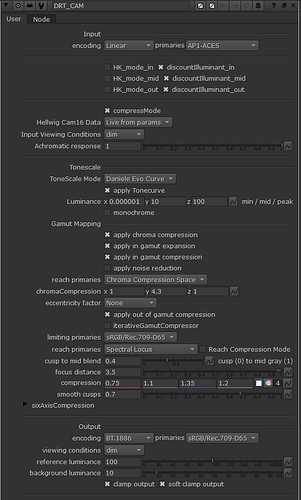I’ve sent a pull request for CAM DRT v046 for @alexfry. It brings the following changes:
- Improves HDR/SDR match
- Adds the chroma compression space as optional reach space for gamut mapper
- Adds AP0, AP1 and Rec.2020 as optional reach spaces for chroma compression
Chroma Compression Space
I haven’t previously plotted the chroma compression space, so here are the chroma compression primaries used in v046:
| CIE x | CIE y | |
|---|---|---|
| Red | 0.7347 | 0.2653 |
| Green | 0.12 | 0.88 |
| Blue | 0.08 | -0.04 |
| White | 0.32168 | 0.33767 |
The following diagram shows AP0, the chroma compression space, and AP1, in that order from widest to narrowest:
In this version these primaries are also available to be used in the gamut mapper when reach mode is enabled:

I also added AP0, AP1 and Rec.2020 as alternative chroma compression primaries:

HDR/SDR Match
This version should have improved appearance match between Rec.709 and Rec.2100. I also tested Rec.2100 against ACES1 Rec.709 since it was found to match well with Rec.2100. I found that it matched well also. To my eye it was following reasons why it matched well:
- Rec.2100 was too colorful. It was matching the saturation level of ACES1 more than CAM DRT v044/45. This has now been adjusted in v046.
- Higher contrast of ACES1 makes certain images feel brighter and closer to Rec.2100. CAM DRT Rec.709 can feel darker. This applies only for the top end. Bottom end is darker in ACES1 and doesn’t match at all.
- Some colors (like green) seems to benefit from clipping and skewing towards the primary in ACES1, making it feel closer to Rec.2100 green (the “Fairy Bottle” effect). I found many more examples where the skew caused it to not match at all.

